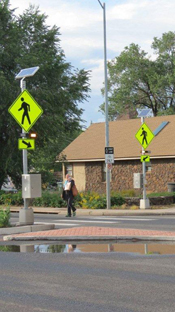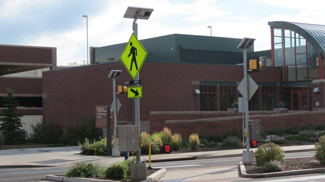
Video
Español
Get a Quote
Systems / Products
Applications
Data Sheets
Product Line
Articles / References
News Releases
Specialty Systems
Design Guides / Get Quote
AC-Powered Controls New
Area & In-Roadway Lighting
Fire Chiefs: Firefighting
High Water Sensor
Industrial
Police Chiefs
Public Works
Roadway Sensor Power
Safe Routes to School
Traffic Calming
Unusual Projects
Customer Service
Contact Us
FAQs
Send Us Your Requirements
Wireless Traffic Control Solutions: A Primer
About STC
Trade Shows & Events
Eco-Opportunity
Bio - Joe Wise
Media Fact Sheet
Links
FIRST
EVIT
Solar Electric Basics
Traffic Systems & Technology
Trafficalm Systems
Magnaray International
BarcodesInc/Electronics
| STC In The News
Upgrades: STC Crosswalk System to RRFB Configuration for Test
Flagstaff is participating in RRFB studies being conducted by the Federal Highway Administration through Texas Transportation Institute (TTI) to ascertain what makes the RRFB purportedly a more effective crosswalk treatment than existing round beacons. Is it the pulse rate, lamp size, lamp shape, lamp placement, or lamp intensity? The engineering company doing the studies went to Flagstaff earlier this summer to monitor motorist's response at the crosswalk using a single 12-inch amber beacon facing traffic, flashing at the standard 50-60 FPM with a 50 per cent duty cycle. It should be noted that the original test conditions included a 30-inch x 30-inch, W11-2 sign on what appeared to be high intensity or diamond grade sheeting in a standard yellow color. The original crosswalk signage did not include the W167P arrow sign pointing to the crosswalk. To prepare for the next round of testing, the city contacted STC to find out if the Solar Ped-X crosswalks could be upgraded to RRFBs utilizing most of the existing equipment. STC engineering came up with a conversion kit to facilitate this change. The conversion work for the controls was done in Flagstaff's traffic sign shop by Joe Wise. The field changes were implemented by Steven Hill and members of his sign crew at the crosswalk site. The crosswalk features a protected pedestrian island in the middle of the four lane road and had to be converted in sections. Unfortunately, only one leg was completed the first day due to weather issues. Upon completion, the WB leg of the crosswalk was outfitted with STC Type 2 RRFB indications which feature dual 3-inch x 7-inch lamps on the leading edge and a high intensity confirmation lamp on the end cap. The W11-2 sign was upgraded to a 36-inch x 36-inch FYG diamond grade sign; a W167P arrow sign was installed as well. STC noted that this adds another variable to the prior studies done by the TTI study team and should be noted in final analysis for the study since better signage can impact the results. When asked about test criteria for placement of the RRFB assembly, city personnel indicated they did not have any specific direction for the test. Subsequently, STC and the city agreed to install the RRFB between the W11-2 and the W167P sign.
The city plans to revert back to the RRFB signals pending final study results. STC DC LED lamps will work with the RRFB flash pattern and were shown earlier this year at the Western Section ITE show and the IMSA International Conference in Phoenix with and without rectangular masks. Celebrating our 12th year designing and manufacturing solar-powered traffic control systems. For more information on STC's products and services, please stay here on our website or send an email to info@solar-traffic-controls.com or call 480.449.0222.
|
CAGE Code 4GN91
| Site by Artique Design Works | © 2001 - 2024 Solar Traffic Controls, L.L.C. - All Rights Reserved |
 TEMPE, AZ - 09/02/2013 - The City of Flagstaff, AZ, a longtime user of STC
equipment, upgraded a Solar Ped-X wireless crosswalk to an RRFB
configuration. The upgrade is due in part to the city's efforts to
standardize its crosswalk locations to RRFB indication.
TEMPE, AZ - 09/02/2013 - The City of Flagstaff, AZ, a longtime user of STC
equipment, upgraded a Solar Ped-X wireless crosswalk to an RRFB
configuration. The upgrade is due in part to the city's efforts to
standardize its crosswalk locations to RRFB indication.
 The system will run approximately five weeks prior to additional data being
taken at the location. Then the city will change the indications to 12-inch
amber LEDs again to test them as a Circular Rapid Flash Beacon (CRFB). The
12-inch DC amber beacons will operate with the RRFB flash pattern as part of
the test. The system will be configured this way for another five weeks for
the next phase of the test to allow motorists time to adapt to the change.
The system will run approximately five weeks prior to additional data being
taken at the location. Then the city will change the indications to 12-inch
amber LEDs again to test them as a Circular Rapid Flash Beacon (CRFB). The
12-inch DC amber beacons will operate with the RRFB flash pattern as part of
the test. The system will be configured this way for another five weeks for
the next phase of the test to allow motorists time to adapt to the change.